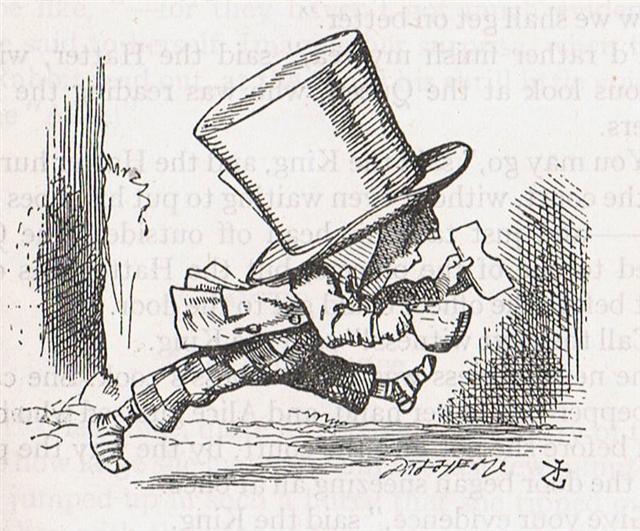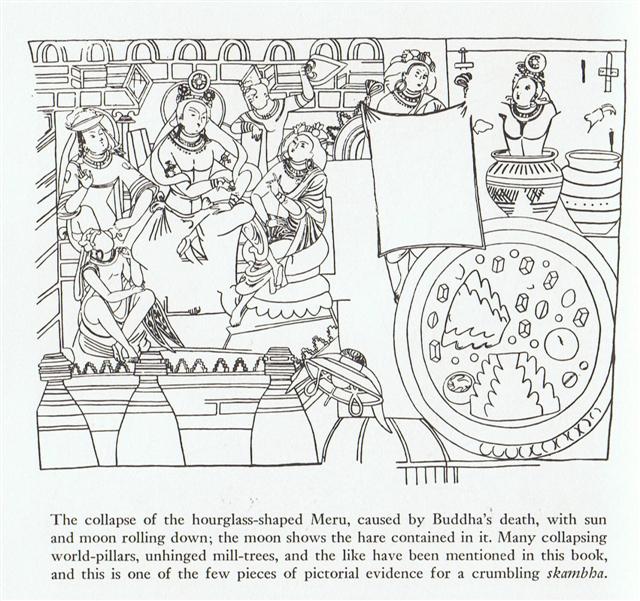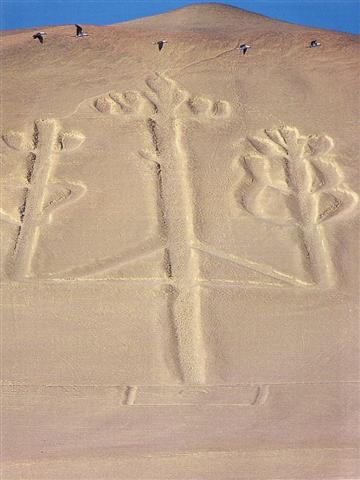The neglected works of Fornander are worthy of study:
There is a cup (σκυφος) in the right hand of the Mad Hatter and he is bent forward (κυπτω) rushing madly ahead - head hidden inside a much too large hat and with his childish face in the shadows. In the description below from the Chinese Turkestan the last chapter of life is hidden from view, and beyond comes a jar (kumbha) inside which there is a person with no arms (like in the nuku typ of glyph):
And then follows - slightly behind - another kind of jar designed to keep the liquid in place:
... The four males and the four females were couples in consequence of their lower, i.e. of their sexual parts. The four males were man and woman, and the four females were woman and man. In the case of the males it was the man, and in the case of the females it was the woman, who played the dominant role. They coupled and became pregnant each in him or herself, and so produced their offspring. But in the fullness of time an obscure instinct led the eldest of them towards the anthill which had been occupied by the Nummo. He wore on his head a head-dress and to protect him from the sun, the wooden bowl he used for his food. He put his two feet into the opening of the anthill, that is of the earth's womb, and sank in slowly as if for a parturition a tergo. The whole of him thus entered into the earth, and his head itself disappeared. But he left on the ground, as evidence of his passage into that world, the bowl which had caught on the edges of the opening. All that remained on the anthill was the round wooden bowl, still bearing traces of the food and the finger-prints of its vanished owner, symbol of his body and of his human nature, as, in the animal world, is the skin which a reptile has shed ... (Marcel Griaule, Conversations with Ogotemmêli.) Metoro said hakaturou (to curse) instead of the expected hakaturu (to bend down, to descend) at the place behind the quadrangular curtain ('noon'), at the hook (tumbuk) type of sign:
696 = 24 * 29 and 126 = 7 * 18 = 9 * 14. Hakarava hakaturu = quadrangular.
... Two thousand miles of empty ocean and the deeps of the Chile Basin separate Easter Island from the west coast of South America. A due-east course would lead voyagers from the island to make landfall in Chile. But a course somewhat to the north of east might bring a ship eventually to the safe haven of the bay of Paracas in Peru, which lies on a meridian exactly 180 degrees of longitude east - and west - of the temples of Angkor in Cambodia. We came across the water from the north in a small open boat, skirting the arid Balestas islands, now a marine sanctuary, and heading for the Paracas peninsula, where rolling sandstone hills and escarpments drop steeply into the sea. From more than 15 kilometers off-shore we had been able to make out the so-called 'Candelabra of the Andes', first through binoculars and then in direct sight. It lay due south of us, carved into a sloping cliff, looming ever larger in our field of view as we approached. The scholarly consesus is that this huge earth-diagram could easily be 2000 years old and is most likely to have been the work of the same people who created the better-known Nazca lines which are found inland, some 300 kilometers to the south. This 'Nazca culture', about which very little is known, is thought to have flourished from the second century BC until about 600 AD. The 'Candelabra' has a rectangular, box-like base, enclosing a circle, out of which rises the representation of a wide central vertical bar, more than 240 meters in length, running north to south. This is crossed, about one-third of the way up, by a triangular contraption running east to west for some 120 meters, supporting two shorter vertical bars. All three bars are surmounted by curious patterns generally interpreted as flames or rays of light. Because of its auspicious geodetic location half-way round the world from Angkor and 108 degrees west of Giza - sites that both 'resemble the sky' by modelling specific constellations on the ground - we have naturally considered the possibility that the Candelabra could be a work of celestial imitation. What particularly invites this enquiry is the orientation of the diagram. It is set very closely to true north-south, the meridian of the sky, the great dividing-line across which astronomers in all cultures have traditionally observed the 'transits' of stars. The Candelabra was intended by its designers to be seen from the north. Indeed, there is no other perspective from which it may be satisfactorily viewed: the observer must face south towards the sloping escarpment on which it is carved. Examining the diagram from the base up naturally draws the eyes towards the southern sky above the escarpment, and specifically towards the south meridian. Although it may be entirely coincidental, computer simulations tell us that at around the hour of midnight on the March equinox 2000 years ago - the epoch in which the Candelabra was probably made - the constellation known as Crux (the Southern Cross) would have been seen lying on the south meridian at an altitude of 52 degrees. At that moment an observer positioned on a boat as we now were, about a kilometre north of the Candelabra, would have seen the Southern Cross suspended in the sky directly above the great cliff diagram ... (Graham Hancock, Heaven's Mirror. Quest for the Lost Civilization.) Fornander again:
|





